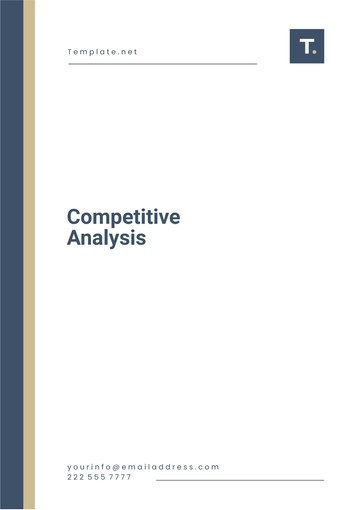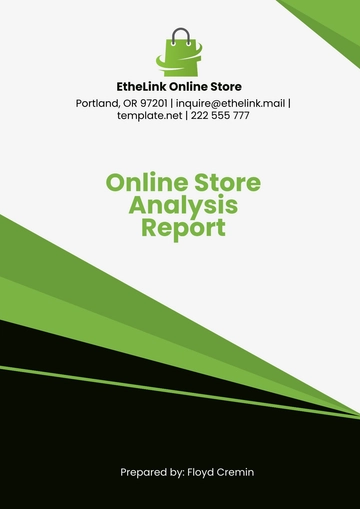Free Car Rental Competitive Analysis

I. Executive Summary
The purpose of this competitive analysis is to evaluate the current market landscape for the car rental industry and identify opportunities and threats for [Your Company Name]. This analysis includes a detailed review of key competitors, market trends, and customer preferences to provide actionable insights and strategic recommendations. By understanding the competitive dynamics and market conditions, [Your Company Name] can strategically position itself to capitalize on growth opportunities and mitigate potential risks.
In this report, we examine major players in the car rental industry, their market share, strengths, weaknesses, and strategic moves. We also delve into key market trends such as the increasing adoption of digital technologies, the push for sustainability, and the growing importance of customer experience. Additionally, we conduct a SWOT analysis to assess [Your Company Name]'s internal and external environment, and propose strategic initiatives to enhance its market position.
II. Industry Overview
A. Market Size and Growth
The global car rental market is projected to grow from $100 billion in 2050 to $120 billion by 2052, at a compound annual growth rate (CAGR) of 5.2%. This growth is driven by several factors, including the increasing demand for travel and tourism, the rise of urbanization, and the growing popularity of ride-sharing services. The market is also benefiting from the increasing number of business travelers who require rental cars for corporate trips. Furthermore, the shift towards more flexible and short-term vehicle access solutions is boosting the demand for car rentals.
B. Market Segments
Leisure Rentals: This segment accounts for 60% of the market, driven by tourism and personal travel. Leisure travelers typically rent cars for vacations, weekend getaways, and family trips. This segment is highly seasonal, with peak demand during holidays and vacation seasons. Companies in this segment often offer a wide range of vehicles, from economy cars to luxury SUVs, to cater to the diverse needs of leisure travelers.
Business Rentals: This segment comprises 30% of the market, with demand from corporate clients and business travelers. Business rentals are characterized by longer rental periods and higher frequency of rentals. Corporate clients often seek premium vehicles and value-added services such as chauffeur services and airport pick-ups. To attract business customers, rental companies offer corporate discounts, loyalty programs, and tailored rental packages.
Other Segments: This category includes long-term rentals, car-sharing services, and peer-to-peer rentals, making up 10% of the market. Long-term rentals cater to customers who need a vehicle for several weeks or months, often at a discounted rate. Car-sharing services allow users to rent vehicles on an hourly basis, providing flexibility for urban commuters. Peer-to-peer rentals, where individuals rent out their personal vehicles, are also gaining popularity as part of the sharing economy.
C. Key Trends
Digital Transformation: The increasing adoption of mobile apps and online platforms for booking and managing car rentals is transforming the industry. Customers now expect seamless digital experiences, including easy booking, real-time vehicle tracking, and automated check-in/check-out processes. Rental companies are investing in advanced technologies such as artificial intelligence (AI) and machine learning to enhance their digital offerings and improve operational efficiency.
Sustainability: There is a growing preference for electric and hybrid vehicles among environmentally conscious consumers. Car rental companies are expanding their fleets with green vehicles to meet this demand and comply with stricter environmental regulations. Additionally, sustainability initiatives such as carbon offset programs and eco-friendly practices in fleet management are becoming more common.
Customer Experience: Enhanced focus on providing superior customer service and personalized experiences is a key trend in the car rental industry. Companies are leveraging customer data and analytics to offer personalized recommendations, loyalty rewards, and tailored services. Improving customer satisfaction through prompt service, well-maintained vehicles, and hassle-free processes is essential for retaining customers and building brand loyalty.
III. Competitive Landscape
A. Major Competitors
Enterprise Rent-A-Car
Market Share: 25%
Strengths: Enterprise Rent-A-Car boasts an extensive network of rental locations, a strong brand reputation, and a wide range of vehicles. The company's commitment to customer service and comprehensive fleet management systems has helped it maintain a leading position in the market. Enterprise also benefits from its diversified business model, which includes car sales and leasing.
Weaknesses: Despite its strengths, Enterprise faces challenges related to higher pricing compared to budget competitors. The company's focus on premium services and extensive fleet management can result in higher operational costs, which are often passed on to customers in the form of higher rental rates.
Hertz Global Holdings
Market Share: 20%
Strengths: Hertz has a strong global presence, with operations in more than 150 countries. The company has a robust corporate customer base and offers premium vehicle options, catering to both leisure and business travelers. Hertz's strong brand recognition and extensive marketing efforts contribute to its competitive advantage.
Weaknesses: Hertz has faced financial instability in recent years, impacting its ability to invest in fleet expansion and technology upgrades. Additionally, the company's focus on premium services means it has fewer budget options, limiting its appeal to price-sensitive customers.
Avis Budget Group
Market Share: 18%
Strengths: Avis Budget Group offers a diverse fleet of vehicles, a robust loyalty program, and competitive pricing. The company's dual-brand strategy, with Avis targeting the premium market and Budget catering to budget-conscious customers, allows it to capture a broad customer base. Avis Budget's strong presence in airport locations and partnerships with travel agencies further enhance its market position.
Weaknesses: Despite its strengths, Avis Budget has faced customer service issues, impacting its reputation. The company's network is less extensive compared to Enterprise, limiting its reach in certain regions. Additionally, operational inefficiencies and high debt levels have posed challenges for the company's financial performance.
Sixt SE
Market Share: 12%
Strengths: Sixt SE is known for its high-end vehicle offerings and strong presence in Europe. The company's innovative technology and customer-focused approach have contributed to its growth. Sixt's strategic partnerships with airlines and hotels, as well as its emphasis on premium service, differentiate it from competitors.
Weaknesses: Sixt's limited footprint in North America restricts its global market share. The company's focus on premium services also means higher prices, which may deter budget-conscious customers. Additionally, Sixt's reliance on the European market makes it vulnerable to regional economic fluctuations.
B. Emerging Players
Turo
Market Share: 5%
Strengths: Turo operates a peer-to-peer rental model, allowing car owners to rent out their personal vehicles. This model provides flexibility in vehicle choices and competitive pricing, making it attractive to a wide range of customers. Turo's strong online platform and user-friendly app enhance the customer experience.
Weaknesses: Turo faces challenges related to trust and safety concerns, as the quality and condition of rental vehicles can vary. The company's decentralized model can lead to inconsistent customer experiences. Additionally, regulatory issues in certain regions can impact Turo's operations.
Getaround
Market Share: 3%
Strengths: Getaround offers a car-sharing model with a tech-driven platform, targeting urban commuters and short-term renters. The company's focus on technology, including keyless entry and real-time tracking, enhances convenience for users. Getaround's emphasis on sustainability and urban mobility aligns with current market trends.
Weaknesses: Getaround's limited geographical reach restricts its market penetration. The company's dependency on vehicle availability and owner participation can impact service consistency. Additionally, competition from other car-sharing services and regulatory challenges pose threats to Getaround's growth.
C. Competitive Analysis Table
Competitor | Market Share | Strengths | Weaknesses |
|---|---|---|---|
Enterprise | 25% | Extensive network, strong brand reputation, wide range of vehicles | Higher prices, higher operational costs |
Hertz | 20% | Global presence, strong corporate customer base, premium vehicle options | Financial instability, limited budget options |
Avis Budget | 18% | Diverse fleet, robust loyalty program, competitive pricing | Customer service issues, less extensive network |
Sixt | 12% | High-end vehicle offerings, strong presence in Europe, innovative technology | Limited footprint in North America, higher prices |
Turo | 5% | Peer-to-peer rental model, flexibility in vehicle choices, competitive pricing | Trust and safety concerns, inconsistent customer experience |
Getaround | 3% | Car-sharing model, tech-driven platform, urban focus | Limited geographical reach, dependency on vehicle availability |
IV. SWOT Analysis for [Your Company Name]
A. Strengths
Extensive Fleet: [Your Company Name] offers a wide range of vehicles to meet diverse customer needs, from economy cars to luxury SUVs and electric vehicles. This extensive fleet ensures that customers can find a vehicle that suits their preferences and requirements.
Strong Brand Reputation: [Your Company Name] is trusted by customers for reliability and quality service. The company's commitment to customer satisfaction and well-maintained vehicles has helped build a strong brand reputation in the market.
Innovative Technology: [Your Company Name] utilizes advanced booking and management systems to enhance user experience. Features such as mobile apps for easy booking, real-time vehicle tracking, and automated check-in/check-out processes streamline the rental experience for customers.
Strategic Partnerships: [Your Company Name] has established collaborations with travel agencies, airlines, and corporate clients to boost market presence. These partnerships help drive customer acquisition and offer added convenience for travelers.
B. Weaknesses
Higher Operating Costs: Compared to smaller, budget competitors, [Your Company Name] faces higher operating costs due to its extensive fleet and premium services. These costs can impact profitability and limit the company's ability to compete on price.
Geographical Limitations: [Your Company Name] has a limited presence in emerging markets, which can restrict its growth potential. Expanding into new regions requires significant investment and local market knowledge.
Customer Service Variability: Inconsistent service quality across different locations can affect customer satisfaction. Ensuring standardized service levels and addressing customer complaints promptly are essential for maintaining a positive reputation.
C. Opportunities
Expansion into Emerging Markets: There is significant growth potential in emerging markets such as Asia-Pacific and Latin America. By entering these regions, [Your Company Name] can tap into new customer bases and increase market share.
Sustainability Initiatives: Increasing the fleet of electric and hybrid vehicles aligns with the growing demand for eco-friendly transportation options. [Your Company Name] can differentiate itself by promoting sustainability and reducing its carbon footprint.
Digital Transformation: Enhancing mobile app features and online booking systems can improve customer experience and operational efficiency. Investing in digital technologies such as AI and machine learning can provide a competitive edge.
Loyalty Programs: Developing robust customer loyalty programs can help retain customers and encourage repeat business. Offering rewards, discounts, and personalized services can enhance customer loyalty and drive long-term growth.
D. Threats
Economic Downturns: Economic downturns can lead to a reduction in travel and discretionary spending, impacting demand for car rentals. [Your Company Name] must be prepared to adjust its strategies during economic challenges.
Intense Competition: The car rental industry is highly competitive, with pressure from both traditional and new market entrants. Maintaining competitive pricing and differentiating services are essential to stay ahead in the market.
Regulatory Changes: Compliance with evolving environmental and safety regulations can pose challenges for fleet management and operations. Staying abreast of regulatory changes and ensuring compliance is crucial for avoiding legal issues and penalties.
Technological Disruptions: Rapid advancements in autonomous vehicles and ride-sharing services can disrupt the traditional car rental model. [Your Company Name] must monitor technological trends and adapt its business strategies accordingly.
V. Market Positioning and Strategy
A. Target Market
Leisure Travelers: [Your Company Name] targets leisure travelers by offering competitive pricing and attractive packages for tourists and family vacations. The company provides a wide range of vehicles to suit different travel needs, from compact cars for city exploration to SUVs for road trips.
Business Clients: To attract business clients, [Your Company Name] offers premium services, corporate discounts, and loyalty benefits. The company provides reliable transportation solutions for corporate events, conferences, and business trips, ensuring comfort and convenience for business travelers.
Urban Commuters: [Your Company Name] is expanding car-sharing services and short-term rentals in metropolitan areas to cater to urban commuters. The company's focus on providing flexible and affordable transportation options aligns with the needs of city dwellers seeking convenient and sustainable mobility solutions.
B. Value Proposition
Quality and Reliability: [Your Company Name] ensures high standards of vehicle maintenance and customer service. The company's commitment to quality and reliability builds trust with customers and encourages repeat business.
Convenience and Accessibility: [Your Company Name] offers easy booking through mobile apps and multiple pick-up/drop-off locations. The company's wide network of rental locations provides customers with convenient access to vehicles, enhancing their overall experience.
Competitive Pricing: [Your Company Name] offers attractive rates and promotions to capture price-sensitive segments. By providing value-for-money services, the company can attract a diverse customer base and increase market share.
Sustainability: [Your Company Name] is committed to eco-friendly practices and green vehicle options. The company's focus on sustainability appeals to environmentally conscious consumers and supports its long-term growth strategy.
C. Marketing Strategies
Digital Marketing: [Your Company Name] utilizes search engine optimization (SEO), pay-per-click (PPC) advertising, and social media campaigns to reach target audiences. The company's digital marketing efforts focus on driving online traffic, increasing brand visibility, and generating leads.
Partnerships and Alliances: [Your Company Name] collaborates with airlines, hotels, and travel agencies for bundled offers. These partnerships provide added value for customers and enhance the company's competitive positioning.
Customer Loyalty Programs: [Your Company Name] enhances rewards and incentives for repeat customers through loyalty programs. By offering exclusive discounts, free upgrades, and personalized services, the company encourages customer retention and repeat business.
Brand Awareness Campaigns: [Your Company Name] invests in advertising and sponsorships to strengthen brand presence. The company's brand awareness campaigns highlight its value proposition and differentiate it from competitors.
VI. Financial Analysis
A. Revenue Streams
Daily Rentals: Short-term rentals generate the bulk of revenue for [Your Company Name]. Customers typically rent vehicles for a few days to a week, with pricing based on vehicle type and rental duration.
Corporate Rentals: Long-term and business rentals contribute to steady income. Corporate clients often enter into contracts for recurring rentals, providing a reliable revenue stream.
Car Sharing: Emerging revenue stream from urban car-sharing services. [Your Company Name] offers flexible, hourly rental options for urban commuters and short-term users.
Ancillary Services: Additional income from insurance, GPS rentals, child seats, and other add-ons. These services enhance customer convenience and increase overall revenue.
B. Cost Structure
Fleet Maintenance: Regular servicing and repairs are essential to ensure vehicle reliability and safety. [Your Company Name] invests in preventive maintenance to minimize downtime and extend the lifespan of its fleet.
Operational Costs: Expenses related to staffing, rental locations, and administrative functions are significant components of [Your Company Name]'s cost structure. Efficient management of these costs is crucial for maintaining profitability.
Marketing and Sales: Budget allocation for advertising, promotions, and sales efforts. [Your Company Name] invests in marketing campaigns to attract new customers and retain existing ones.
Technology Investments: Continuous upgrades to digital platforms and booking systems enhance customer experience and operational efficiency. [Your Company Name] allocates funds for technology development and implementation.
C. Profitability Analysis
Year | Revenue ($ million) | Cost of Goods Sold ($ million) | Gross Profit ($ million) | Operating Expenses ($ million) | Net Profit ($ million) |
|---|---|---|---|---|---|
2050 | 550 | 330 | 220 | 110 | 110 |
2051 | 600 | 360 | 240 | 120 | 120 |
2052 | 660 | 396 | 264 | 132 | 132 |
The table above provides a detailed profitability analysis for [Your Company Name] over the next four years. The company is expected to achieve steady revenue growth, driven by increased demand for car rentals and effective marketing strategies. By maintaining control over operating expenses and optimizing fleet management, [Your Company Name] can achieve sustainable profitability.
VII. Recommendations
A. Strategic Initiatives
Market Expansion: [Your Company Name] should focus on entering new geographic markets with high growth potential, particularly in Asia-Pacific and Latin America. These regions offer significant opportunities due to increasing urbanization, rising disposable incomes, and growing demand for travel and transportation services.
Fleet Diversification: Increasing the number of electric and hybrid vehicles in [Your Company Name]'s fleet can attract eco-conscious customers and comply with environmental regulations. The company should invest in green technologies and promote its sustainability initiatives to differentiate itself from competitors.
Enhanced Digital Experience: [Your Company Name] should continue to invest in mobile app development and online booking enhancements. Features such as AI-driven recommendations, real-time availability updates, and seamless payment options can improve user experience and increase customer satisfaction.
Customer Loyalty Enhancement: Developing comprehensive loyalty programs can help [Your Company Name] retain customers and encourage repeat business. Offering personalized rewards, exclusive discounts, and premium services can enhance customer loyalty and drive long-term growth.
B. Operational Improvements
Cost Optimization: [Your Company Name] should implement measures to reduce operational costs without compromising service quality. This can include optimizing fleet utilization, streamlining administrative processes, and negotiating better terms with suppliers.
Service Standardization: Ensuring consistent customer service across all locations is essential for maintaining a positive reputation. [Your Company Name] should invest in staff training, establish standardized procedures, and implement quality control measures to enhance service delivery.
Technology Integration: Adopting new technologies, such as AI and the Internet of Things (IoT), can streamline operations and improve efficiency. [Your Company Name] should explore the use of telematics for fleet management, predictive maintenance, and customer engagement.
C. Marketing and Sales Strategies
Targeted Advertising: Using data analytics to identify and target high-potential customer segments with tailored marketing campaigns can enhance [Your Company Name]'s marketing effectiveness. Personalized ads, email marketing, and social media engagement can drive customer acquisition and retention.
Partnership Collaborations: Strengthening partnerships with airlines, hotels, and travel agencies can expand [Your Company Name]'s reach and attract a wider customer base. Collaborative marketing efforts, joint promotions, and bundled offers can provide added value for customers and increase booking conversions.
Enhanced Online Presence: Improving search engine optimization (SEO) strategies and leveraging pay-per-click (PPC) advertising can drive organic and paid traffic to [Your Company Name]'s website. Enhancing the user interface (UI) and user experience (UX) of the website can increase conversion rates and reduce bounce rates.
Customer Feedback and Reviews: Actively soliciting customer feedback and reviews can provide valuable insights into service improvements and customer preferences. Implementing a robust review management system and responding promptly to customer feedback demonstrates [Your Company Name]'s commitment to customer satisfaction.
D. Risk Mitigation Strategies
Economic Volatility: [Your Company Name] should establish financial contingency plans to mitigate the impact of economic downturns on revenue and profitability. Diversifying revenue streams and maintaining a flexible cost structure can enhance resilience during economic uncertainties.
Competitive Pressure: Monitoring competitors' pricing strategies, service offerings, and market expansions can help [Your Company Name] anticipate competitive threats and adjust its own strategies accordingly. Differentiating through unique value propositions and continuous innovation is essential for maintaining a competitive edge.
Regulatory Compliance: Keeping abreast of evolving regulatory requirements and industry standards is crucial for [Your Company Name]'s operations. Establishing robust compliance frameworks, conducting regular audits, and investing in legal counsel can mitigate legal risks and ensure adherence to regulations.
Technological Disruptions: Embracing technological advancements and investing in future-ready solutions can prepare [Your Company Name] for potential disruptions in the car rental industry. Monitoring trends in autonomous vehicles, AI-driven mobility solutions, and digital platforms can inform strategic investments and partnerships.
VIII. Conclusion
In conclusion, the car rental industry presents lucrative opportunities for [Your Company Name] amidst evolving consumer preferences, technological advancements, and market dynamics. By conducting a comprehensive competitive analysis, [Your Company Name] gains valuable insights into competitors' strengths, weaknesses, and strategic moves. Leveraging these insights, [Your Company Name] can formulate effective strategies to enhance market position, drive growth, and achieve sustainable competitive advantage.
As [Your Company Name] navigates through competitive challenges and capitalizes on emerging opportunities, strategic initiatives such as market expansion, fleet diversification, enhanced digital experience, and customer loyalty enhancement will be pivotal. By focusing on operational excellence, customer-centricity, and innovation, [Your Company Name] can reinforce its position as a leader in the global car rental market.
- 100% Customizable, free editor
- Access 1 Million+ Templates, photo’s & graphics
- Download or share as a template
- Click and replace photos, graphics, text, backgrounds
- Resize, crop, AI write & more
- Access advanced editor
Explore the Car Rental Competitive Analysis Template on Template.net, customizable and editable for in-depth market insights. Utilize our Ai Editor Tool to analyze competitors effectively, identifying strengths and opportunities to enhance your rental business's competitive edge.





























